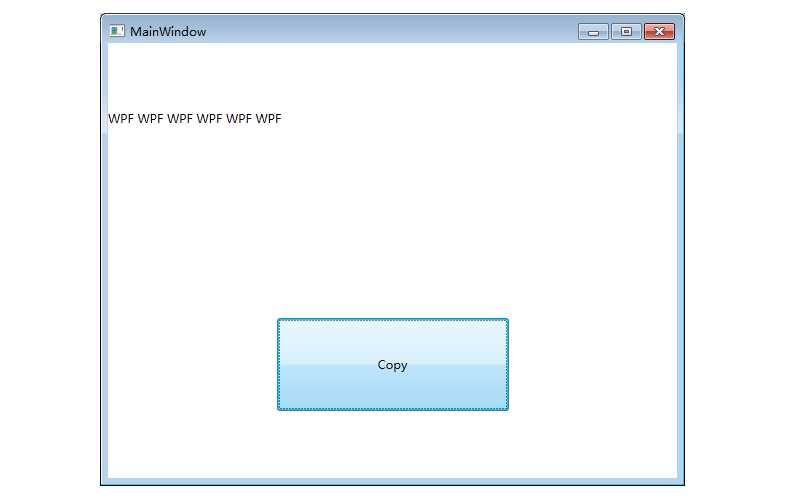标签:
http://www.cnblogs.com/xjxz/archive/2012/11/14/WPF.html
本篇从两个方面来讨论MVVM模式:
从上一篇文章中,我们已经知道,WPF技术的主要特点是数据驱动UI,所以在使用WPF技术开发的过程中是以数据为核心的,WPF提供了数据绑定机制,当数据发生变化时,WPF会自动发出通知去更新UI。
我们使用模式,一般是想达到高内聚低耦合。在WPF开发中,经典的编程模式是MVVM,是为WPF量身定做的模式,该模式充分利用了WPF的数据绑定机制,最大限度地降低了Xmal文件和CS文件的耦合度,也就是UI显示和逻辑代码的耦合度,如需要更换界面时,逻辑代码修改很少,甚至不用修改。与WinForm开发相比,我们一般在后置代码中会使用控件的名字来操作控件的属性来更新UI,而在WPF中通常是通过数据绑定来更新UI;在响应用户操作上,WinForm是通过控件的事件来处理,而WPF可以使用命令绑定的方式来处理,耦合度将降低。
我们可以通过下图来直观的理解MVVM模式:
View就是用xaml实现的界面,负责与用户交互,接收用户输入,把数据展现给用户。
ViewModel,一个C#类,负责收集需要绑定的数据和命令,聚合Model对象,通过View类的DataContext属性绑定到View,同时也可以处理一些UI逻辑。
Model,就是系统中的对象,可包含属性和行为。一般,View对应一个ViewModel,ViewModel可以聚合N个Model,ViewModel可以对应多个View,Model不知道View和ViewModel的存在。
这个示例是为了让大家直观地了解MVVM的编程模式,关于其中用到的数据绑定和命令等知识,在后面的文章会专门讨论。
using System.ComponentModel;
namespace WpfFirst
{
class NotificationObject : INotifyPropertyChanged
{
public event PropertyChangedEventHandler PropertyChanged;
public void RaisePropertyChanged(string propertyName)
{
if (this.PropertyChanged != null)
{
this.PropertyChanged(this, new PropertyChangedEventArgs(propertyName));
}
}
}
}
2.定义DelegateCommand类。目的是绑定命令属性。这个类的作用是实现了ICommand接口,WPF中实现了ICommand接口的类,才能作为命令绑定到UI。命令的知识,后面详细讨论。
using System;
using System.Collections.Generic;
using System.Windows.Input;
namespace WpfFirst
{
class DelegateCommand : ICommand
{
//A method prototype without return value.
public Action<object> ExecuteCommand = null;
//A method prototype return a bool type.
public Func<object, bool> CanExecuteCommand = null;
public event EventHandler CanExecuteChanged;
public bool CanExecute(object parameter)
{
if (CanExecuteCommand != null)
{
return this.CanExecuteCommand(parameter);
}
else
{
return true;
}
}
public void Execute(object parameter)
{
if (this.ExecuteCommand != null) this.ExecuteCommand(parameter);
}
public void RaiseCanExecuteChanged()
{
if (CanExecuteChanged != null)
{
CanExecuteChanged(this, EventArgs.Empty);
}
}
}
}
3.开始定义Model类。一个属性成员"WPF",它就是数据属性,的有通知功能,它改变后,会知道通知UI更新。一个方法“Copy”,用来改变属性“WPF”的值,它通过命令的方式相应UI事件。
using System.ComponentModel;
using System.Windows.Input;
namespace WpfFirst
{
class Model : NotificationObject
{
private string _wpf = "WPF";
public string WPF
{
get { return _wpf; }
set
{
_wpf = value;
this.RaisePropertyChanged("WPF");
}
}
public void Copy(object obj)
{
this.WPF += " WPF";
}
}
}
4.定义ViewModel类。定义了一个命令属性"CopyCmd",聚合了一个Model对象"model"。这里的关键是,给CopyCmd命令指定响应命令的方法是model对象的“Copy”方法。
using System;
namespace WpfFirst
{
class ViewModel
{
public DelegateCommand CopyCmd { get; set; }
public Model model { get; set; }
public ViewModel()
{
this.model = new Model();
this.CopyCmd = new DelegateCommand();
this.CopyCmd.ExecuteCommand = new Action<object>(this.model.Copy);
}
}
}
5.定义View.
MainWindow.xaml代码:我们能看到,TextBlock控件的text属性,绑定在model对象的WPF属性上; Button的click事件通过命令绑定到CopyCmd命令属性。
<Window x:Class="WpfFirst.MainWindow"
xmlns="http://schemas.microsoft.com/winfx/2006/xaml/presentation"
xmlns:x="http://schemas.microsoft.com/winfx/2006/xaml"
Title="MainWindow" Height="350" Width="525">
<Grid>
<StackPanel VerticalAlignment="Center" >
<TextBlock Text="{Binding model.WPF}" Height="208" TextWrapping="WrapWithOverflow"></TextBlock>
<Button Command="{Binding CopyCmd}" Height="93" Width="232">Copy</Button>
</StackPanel>
</Grid>
</Window>
MainWindow.xaml.cs代码:它的工作知识把ViewModel对象赋值到DataContext属性,指定View的数据源就是这个ViewModel。
using System.Windows;
namespace WpfFirst
{
/// <summary>
/// Interaction logic for MainWindow.xaml
/// </summary>
public partial class MainWindow : Window
{
public MainWindow()
{
InitializeComponent();
this.DataContext = new ViewModel();
}
}
}
6.运行结果。每当我们点击按钮,界面就是被更新了,因为Copy方法改变了WFP属性的值。

写这个简单的例子,就是为了直观地了解MVVM的编程模式。在实际开发中,不管程序有多复杂,也就是增加Model, View, ViewModel,和其他的一些辅助类(Helpers or Services)了,模式不会改变。
标签:
原文地址:http://www.cnblogs.com/jamey/p/5151228.html